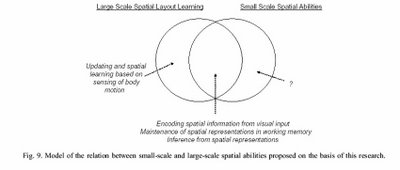 [Double click image to enlarge}
[Double click image to enlarge}In what way are learning your way around a city your are visiting, playing the XBOX game HALO, and solving visual-spatial tasks on intelligence tests alike? How are they the same? How are they different?
These questions have fascinated me ever since I was recently introduced to the world of HALO. Watching teenagers and young adults play HALO, which requires lighting fast reaction time (Gt), plus the ability to remember the spatial layouts of complex buildings and terrains (from one gaming session to another), has boggled my mind. After considerable “egging on” by some seasoned HALO youth….I gave it a try. To be blunt………I was a disaster.
In my few attempts at HALO, I was killed repeatedly and could not get the action figure I was controlling to do nothing more than spin in circles and fire rounds at my feet or up in the air. Once I learned how move (like a baby), navigating the various maze layouts was daunting. I was completely lost, while the youngsters were literally running and moving around corners, jumping levels, moving through doors, etc., all the while shooting with unbelievable accuracy. They had clearly, via considerable sustatined motivated practice, internalized the spatial configuration of these various virtual environments.
I began to wonder if there was any correlation between visual-spatial psychometric test performance and performance in visual-spatial “wayfinding” in these virtual game environments. Partial answers to my questions were recently answered in the following article published in the journal Intelligence (click here to view/download).
The abstract is below. Also below are a few select conclusions and comments.
- The bottom line is that small-scale psychometric visual-spatial (Gv) tasks do demonstrate significant correlations with navigation in large-scale virtual media environments (HALO), but are not strongly associated with navigation in large-scale real environments (wayfinding in a new city).
- There are large individual differences in large-scale spatial learning. [Comment – no s__t batman!!!! I obviously am at the bottom of the distribution in large-scale virtual reality spatial learning]
- The research supports a model (see graphic above) that suggest partial, rather than total, dissociation between large-scale and small-scale spatial (Gv) abilities.
- Measures of spatial learning from real environments and measures of learning from visual media are partially dissociated and load on different Gv factors. Do these findings, together with the correlated, yet separate, construct validity for psychometric Gv abilities, suggest a need to revise the CHC Gv taxonomy via the inclusion of different types of large-scale navigation Gv abilities? Is there a need to differentiate Gv abilities along the dimension of scale (large- vs. small-scale processing).
- The shared variance between small-scale psychometric Gv and large-scale navigational Gv appears to represent a shared/common visual-spatial processing ability and is not due to the influence of verbal (Gc) abilities or general intelligence (g).
- With myself being an obvious outlier, performance on small-scale psychometric visual-spatial tasks reasonably predicts performance on large-scale visual/virtual media Gv tasks. An obvious question is whether sustained practice on virtual-reality games (e.g., HALO), that place strong demands on visual configuration navigation, visual working memory, visual updating, etc., result in improvement in small-scale Gv performance over time? Is the current generation of video gamers raising the mean level of Gv abilities on traditional psychometric measures?
- Anyone who loves to conduct secondary analysis of published correlation/covariance matrices (via SEM/CFA methods) should find the matrix reported in this article lots of fun.
Hegarty, M., Montello, A. Richardson, A. (2006) Spatial abilities at different scales: Intelligence 34 (2006) 151– 176
Abstract
- Most psychometric tests of spatial ability are paper-and-pencil tasks at the “figural” scale of space, in that they involve inspecting, imagining or mentally transforming small shapes or manipulable objects. Environmental spatial tasks, such as wayfinding or learning the layout of a building or city, are carried out in larger spaces that surround the body and involve integration of the sequence of views that change with one’s movement in the environment. In a correlational study, 221 participants were tested on psychometric measures of spatial abilities, spatial updating, verbal abilities and working memory. They also learned the layout of large environments from direct experience walking through a real environment, and via two different media: a desktop virtual environment (VE) and a videotape of a walk through an environment. In an exploratory factor analysis, measures of environmental learning from direct experience defined a separate factor from measures of learning based on VE and video media. In structural-equation models, smallscale spatial abilities predicted performance on the environmental-learning tasks, but were more predictive of learning from media than from direct experience. The results indicate that spatial abilities at different scales of space are partially but not totally dissociated. They specify the degree of overlap between small-scale and large-scale spatial abilities, inform theories of sex differences in these abilities, and provide new insights about what these abilities have in common and how they differ.
Technorati Tags: psychology, cognition, educaiton, Gv, visual spatial, CHC, CHC theory, XBOX, Halo
